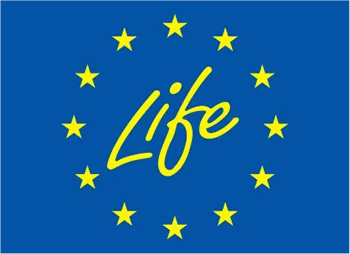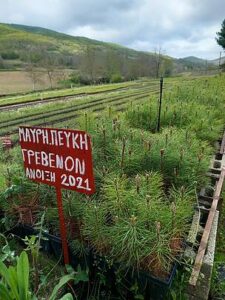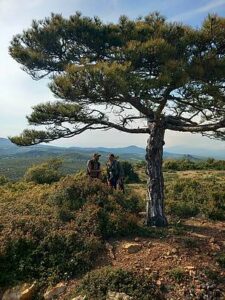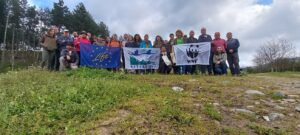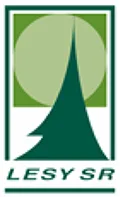The team of CLIMAFORCEE LIFE project joined a field tour for the exchange of experience with the participation of foresters, experts, environmentalists, representatives of the scientific community and volunteers – foresters from different parts of Bulgaria. The filed tour was conducted by LIFE REFOREST project and took place in a large area of Northern Greece and gave the participants from the Bulgarian and Greek sides the opportunity to share ideas, learn more about forest management, and also get to know specific practices for afforestation and adaptation of forests to modern changes in the climate. More than 30 people took part in the trip and discussions, led by the experienced local forest restoration specialist – Petros Kakouros, including representatives of various forestry services from Bulgaria and Greece.
Centuries old olive trees
WWF, which has been actively working for the protection of forests in Bulgaria for years, started the tour with a visit to the oldest olive trees in the area of Alexandroupolis. They are located in the village of Makri and are protected by law, as they are extremely important to local culture and livelihoods, as well as biodiversity conservation. The area has been inhabited since Roman times, and archaeologists have discovered laboratories for the production of olive oil. Today, olive trees are strictly protected, with special requirements for the construction of buildings. Some of them are believed to be between 500 and 1000 years old.
An ecological phenomenon
In the Perama region, at the very edge of the Rhodope Mountains, the participants of the trip saw an ecological phenomenon – a natural regeneration of black pine at an altitude of only 200 meters above sea level and less than five kilometers from the Aegean Sea.
“This is the only place in Greece where the black pine is found so low. Forest Service officials find this unique and strive to preserve it. For this purpose, the area has been declared a natural landmark. This led to the temporary cessation of gold mining that started 20 years ago, which was polluting the area, and allowed the black pine to regenerate naturally. Therefore, the policy of the authorities to introduce control over the level of grazing also helps,” says Petros Kakouros, a specialist in forest restoration.
The Greek Forest Service prioritizes the natural regeneration of forests. They follow this policy even after a fire. They estimate that within 10-15 years the evergreen vegetation at this altitude can regenerate without human intervention, as long as it is protected from grazing. In this way, the new forest grows more resilient to natural disasters and is able to provide sufficient water for the local population. A curious fact is that in Greece 70% of the forests are state-owned, and the local forest services harvest wood with a low intensity compared to most European countries, with bare felling practically not allowed.
How did the Greeks create saplings?
The next step of the tour took the participants to Organi Nursery, which has almost half a century of history. On an area of 6.5 hectares, it traditionally produces conifers, and recently also oak and wild cherry. The nursery is managed by the East Macedonian Thrace Directorate, and field work is coordinated by Mustafa, who is a second-generation forester.
“The first stage in the production of saplings is the preparation of seeds and containers. We use soil collected from the area which we mix with substrate. We sow three or four seeds in one container, but if they catch more than one, we move them to another. In the first week after the seeds germinate, we treat them with fungicides to protect the plant from fungi, which are a big disaster in some areas of Greece. This year we have committed to production of 250,000 saplings of black pine (Pinus nigra), and 40,000 each of the oak and wild cherry species,” says Mustafa, who is the only permanent worker in the nursery. Its staff reaches up to 22 people depending on the season and workload.
Mustafa also told interesting details about the production of the different tree species. The material for the production of wild cherries, for example, must be collected from the area, then placed in a shady place while waiting for the decomposition of the fleshy shell of the pits. Then the seeds are washed and prepared for planting. It is extremely important that they are not exposed to light, as the experience of foresters has shown that solar radiation reduces the germination of seeds.
The coniferous saplings are watered twice a week for three hours with a special irrigation system resembling raindrops. They are grown for one or two years, then reforested. The nursery is currently preparing thousands of black pine saplings that will go to Gravena to help restore the local ecosystem affected by a recent fire.
Old-growth forest at the mouth of the Mesta River
The trip continued with a visit to the information center for riparian forests at the mouth of the Mesta River. According to local guide Dimitris Filiadis, they were once one of the largest in the Mediterranean region. It is believed that only a century ago the riverside forests occupied an area of 12,000 ha. However, in the middle of the 20th century, after bare cuts in the upper part of the works, the river changed its course and as a result completely destroyed two villages. Subsequently, the course of the river was corrected with dikes.
“Then a process of gradual clearing of the forest began to make way for agricultural land. This leads to a change in the ecosystem. Poplar plantations are being created on part of these areas. After the second rotation, however, the forest services realized that the soils were not suitable for such plantations and began to prioritize the preservation of the old forest. This information center was established in 2001 and its program is related to the complete removal of plantations and the restoration of the primary forest,” says Dimitris Filiadis. According to him, 320 ha of natural forests have been restored so far, mainly with pioneer poplars and willows, and more demanding species such as summer oak, ash and elm are located under them.
Fortunately, remnants of the primeval forest have been preserved even today on an area of 150 ha. Access to them is strictly prohibited, as well as any human activities. In these you can see different species of willow, black and white poplar and Black alder (Alnus glutinosa), which are resistant to flooding, but there is also Elm (Ulmus), Ash (Fraxinus) and Quercus robur. This vegetated ecosystem near the river is home to an extraordinary biodiversity.
Livadero Forest Complex
In the mountain Bozdag (in the town of Falakro) there is a forest complex “Livadero” – one of the 15 complexes falling under the jurisdiction of the forestry service in Drama. Elisaveta Constantinidou, who leads a team of over 60 people, is responsible for all of them.
“There are six species of oak and five species of pine, as well as common spruce, beech and chestnut. Over the years and with the increase in the number of people, the territories around the settlements were gradually turned into pastures. In an effort to restore the forest in the 1980s, the authorities created artificial pine plantations. However, this leads to certain problems, such as high costs, low-quality wood and low yields due to insect attacks and poor soils,” explains Elisaveta Constantinidou, director of the forest service in Drama.
Konstantinidou shared with his colleagues that the forest authorities allow the local population within two months of the year to secure their heating during the winter. Each household is allowed to harvest an average of 10 cubic meters of wood, the amount depending on the altitude at which the settlement is located. However, it is expressly forbidden to cut down an oak tree.
What did we learn on the trip?
1) Forests in Greece are strictly protected by the local constitution. Forestry authorities maintain logging at a lower intensity than most European countries. No more than 10% (rarely up to 15%) of the total stock is harvested for the ten-year period of operation of the forest management plan. And eroded soils are left without cutting for at least 20-30 years in order to restore them. For comparison, in Bulgaria the extraction sometimes reaches 30% of the total reserve.
2) Forest services in Greece fall under the jurisdiction of the Ministry of the Environment. The main purpose of their activity is not the economic benefit of logging, but the creation of conditions for the development of the remaining ecosystem services of the forest, such as soil protection, climate regulation, water and biological diversity protection, providing social, scientific and recreational benefits for society.
3) In Greece, as in our country, there is a problem with coppice forests. Therefore, local forest services are actively working to convert them to seed / tall stem. The main method they use is with the application of cultivated cuttings with low intensity. However, it has been used relatively recently and not enough time has yet passed to analyze the results.
A large part of the Bulgarian team on the project “Climate-intelligent management of forests in Central and Eastern Europe” – CLIMAFORCEE LIFE – was involved in the study trip, for whom the exchange of experience on topics related to afforestation of more heat and drought-resistant species is also important. Within the framework of the event, they used the opportunity to conduct a public consultation in relation with the adaptation of forests to climate change.
In addition to the good emotions and wonderful natural landscapes, the participants will remember the field tour and the variety of interesting forestry practices from which they can draw ideas in their daily work in the forests.
The field trip was carried out in the framework of the LIFE REFOREST project “Supporting the restoration, climate resilience and biodiversity significance of priority forest habitats in Natura 2000 areas”, funded by the LIFE program of European Commission.
Photos: Yana Barzova, Konstantin Hristov / WWF
